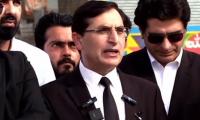Between the two martial laws of Ayub Khan and Ziaul Haq was the five-plus years democratic interregnum of Zulfikar Ali Bhutto, in the first year of which ZAB ruled under the unique sobriquet of a civilian chief martial law administrator.
Not his fault. There wasn’t another law in the country to run it with. He resurrected the 1956 constitution and tuned it as the 1973 constitution. The basic structure remained the same. The only exception was the excision of East Pakistan, which ironically was the underlying reason for its abandonment in 1958.
Between 1947 and 1956, the nation was led by a politico-bureaucrat combine – four prime ministers and four governor-generals. That it took them nine years to graduate to the level of a republic with a constitution speaks of the diversions that had made an entry into governance, chief among them the jockeying for power at the helm.
This model of governance hasn’t changed since. When the principle of one-man one-vote was enshrined in the 1956 constitution, politicians of West Pakistan feared capitulating control to their colleagues in East Pakistan, which led to the dissolution of the constitution and the inception of the first martial law. Thirteen years later, East Pakistan seceded when it could not secure equal rights.
It was in 1951 that the first native, Ayub Khan, was appointed the army chief. He was extended in 1954, and also raised to the level of a defence minister in the cabinet while in uniform. It is believed that this exception may have been encouraged by the US, which had assumed a significant presence in Pakistan. It is likely that as defence minister Ayub Khan was able to exercise some influence in America’s favour, though the die was already cast of Pakistan warming in the American bosom.
This is when Pakistan truly sat in the American camp. Alliances with Cento, Seato and, subsequently, the RCD indicated Pakistan’s need to seek support from a major power against the threatening presence of India. When Ziaul Haq and Musharraf, many years later, seemed to be answering the call to make a similar choice, they were led by the same resident bias inherent in Pakistan’s foreign policy towards the US. Clearly, there were contemporary interests too but a historical inclination was as much a factor.
ZAB was an interesting exception. He was inducted in the Iskander Mirza cabinet in 1958 and remained a critical component of the government under Ayub Khan. He broke with Ayub Khan in 1966 by charting an independent political path, but was firmly back in the fold of Yahya Khan, Ayub’s military successor. Many question Bhutto’s role during the breakup of Pakistan when he seemed to be ambitiously pursuing his own prospects at the cost of the country. Succeeding Yahya after Pakistan had been truly truncated, he attempted to repair his image with politics around a socialist model and an independent foreign policy – anathema in the cold-war years.
Bhutto had many firsts. He formulated a constitution, even if re-oxygenated; created an Afghan desk in the ISI to keep tabs on a politically hostile Afghanistan, violating the code of an uneasy but restrained status quo; and founded a political cell in the ISI to be used to ensure the domination of political foes. These two bodies, now defunct, were at the root of many of Pakistan’s internal and external dilemmas in the decades to follow. The Afghan cell developed into a separate department, which handled Afghanistan in coordination with the CIA in the 1980s.
Ziaul Haq and Musharraf, and many leaders in between, used the resource with abandon in pursuit of interests in Afghanistan, which kept growing as our capacity to influence there grew in proportion. The Baloch insurgency, though rooted in history, reignited during his time, stoking strife in two perpetual sore-points on the western borders. Our relations with Iran or Afghanistan have never recovered since; and neither has Pakistan. A combination of external and internal dynamics saw Bhutto’s aberrational tenure cut short in the second term.
The 1990s were a time of musical chairs between Bhutto’s mercurial daughter, Benazir, and Zia’s adopted son, Nawaz Sharif. Between them, they changed governments five times in 10 years, always sabotaging each other before their tenures would end. The offices of the president, the judiciary and the military always obliged with manipulating a change of the prime minister. The Asghar Khan case is an example. Both leaders were so obsessed with undermining each other that they could never institute any credible or sustaining reform, or change in policy. Sporadic engagement with India aside, the focus always swayed towards the self-serving ends of instituting policy reforms, which augmented their personal and familial well-being. Some reforms by Nawaz Sharif in the economy triggered hopes of a newer paradigm, but he too strayed in implementation. His ongoing predicaments are dated from those times. Foreign policy, and the defence policy flowing out of it, remained straitjacketed by the traditional direction for the lack of sufficient effort in shaping the environment in favour of the nation’s interest.
The 1979 and 2001 wars in Afghanistan engendered a strategic mosaic that Pakistan has been grappling with ever since. In hindsight, both Zia and Musharraf could have been wary of the American hubris, avoiding being engulfed in a debilitating regional turmoil. As Pakistan trundles from one operation to another, and as Afghanistan continues to be overwhelmed by the consequences of America’s war on terror, strategic afterthought is far wiser.
The history of our leadership – political or military – suggests that except for the brief period of ZAB, Pakistan would have toed America’s lead anyway; such has been the pull exercised by the disproportionate American influence in Pakistan. There were other factors too, none so complementary and rather short-sighted, which contributed to such a fait accompli; ZAB’s increased focus on Afghanistan, no less. Similarly, the Taliban were a product of Naseerullah Babar, PPP’s minister for interior during one of Benazir’s tenures. Relations with Afghanistan today must then stand in this backdrop, tapestried folly-by-folly over the last 44 years.
Explaining India is easier. A perpetual enemy continues to engage in newer mutations of war. This divergence in the trajectory of relationship has held over decades. There is little one can do to change the equation unless both tango, despite a desire to move the region towards a more positive regime. Sadly, nothing seems possible under Modi. His likely next tenure may be different. But this for the moment is only a hope. And hopes alone are poor strategies.
To lament a lack of an independent hand in running Pakistan’s foreign policy is more a sham than reflecting on realities dictated by our past guffaws and the ensuing environment. Democratic governments were at their worst when engaging in foreign relations or simply dismissive. The PPP did make some amends but the follow-ups were always weak. To complain of a restrained hand in foreign policy is unfathomable. When you run a government without a foreign minister for four years, there is little that you can hope to achieve. That is the real story behind Pakistan’s stuttering relationships.
Email: shhzdchdhry@yahoo.com
An aeroplane of the national flag carrier of Pakistan is seen in this file photo. — AFPWhile Pakistan considers...
Representational image of a graph depicting various variables. — APP/FileInitiated by the centre and fiercely...
In this picture taken on April 16, 2023, people throng a market area during shopping in Lahore. — AFPOne of the...
Honour crimes also target men. In Sikandar Ali Lashari vs The State, SHC upheld conviction passed by ATC for honour...
If Sindh earmarks Rs20 million per police station, it will cost only Rs10 billion to make them effective first...
A complex and difficult policy environment seems to be highlighted by US’s recent application of sanctions on...







